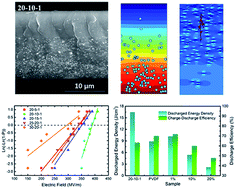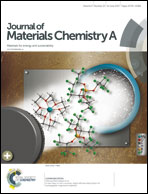Ultrahigh electric displacement and energy density in gradient layer-structured BaTiO3/PVDF nanocomposites with an interfacial barrier effect†
Abstract
Negative environmental consequences of non-renewable energy resources and limited reserves of fossil fuel supplies have spurred the development of renewable and environmentally friendly energies as well as advanced energy conversion and storage technologies. Among the currently available electrical energy storage devices, electrostatic capacitors possess highest power density because of their fast charge–discharge capability. However, their low energy densities limit their applications. Herein, we demonstrated a remarkable improvement in the breakdown strength and energy density of a group of three-tiered ferroelectric polyvinylidene fluoride (PVDF) films with the content of barium titanate (BT) nanoparticle fillers gradually increasing layer by layer. It was found that a weak electric field region could be formed as an efficient insulating barrier to hamper the development of electrical trees via tailoring of the gradient of filler contents. Optimization of the composite compositions guided by simulation studies resulted in a greatly enhanced breakdown strength of 390 MV m−1 with an ultrahigh maximum polarization of 12.5 μC cm−2, and thus, an impressive discharged energy density of 16.5 J cm−3 was achieved. This successful structural design provides a new paradigm to explore polymer nanocomposites having excellent dielectric and capacitive properties, which can also be applied to other materials in electric and electrical applications.



 Please wait while we load your content...
Please wait while we load your content...